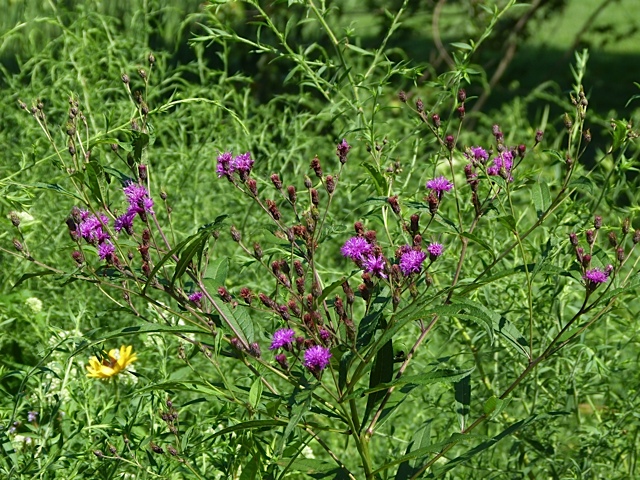Ironweed
By Nancy Arrington
Ironweed (Vernonia noveboracensis)
“I think it pisses God off if you walk by the color purple in a field somewhere and don’t notice it.” –The Color Purple, by Alice Walker
 I was reminded of this quote recently when I saw several clumps of ironweed growing along the Fairfax County Parkway. I always thought she was talking about ironweed because its vivid color in a field, beside the road, or in a garden is hard to ignore.
I was reminded of this quote recently when I saw several clumps of ironweed growing along the Fairfax County Parkway. I always thought she was talking about ironweed because its vivid color in a field, beside the road, or in a garden is hard to ignore.
New York ironweed is one of my favorite late summer natives, and I grow it in several locations in my garden. In a spot of rich, moist soil with four to six hours of sun (similar to its native habitat) it tops out at 6-8’ and its bright purple flowers are a striking contrast with tall, yellow-flowering cup plant (Silphium sp.) and green-headed coneflower (Rudbeckia laciniata).
It’s a good nectar plant for butterflies and other pollinators and in my butterfly garden, with drier soil and only two to four hours of sun, it blooms well at 3-4’. Plants can also be kept shorter by cutting stems by half in early summer. Additional butterfly nectar plants that are good companions include white-flowering flat-top aster (Doellingeria umbellata), both red and blue lobelias (L. cardinalis and siphilitica), turtleheads (Chelone spp.) and summer phlox (P. paniculata), as long as it has been dead-headed to encourage continued blooming. I have read that ironweed attracts hummingbirds, but I haven’t seen them visit plants in my garden.
I am always on the lookout for plants with yellow or chartreuse foliage to brighten my mostly shaded garden. Also a sucker for the oddities, especially natives, that most sensible gardeners don’t grow, I couldn’t resist yellow-leaved pokeweed (Phytolacca americana‘Sunny Side Up’) in Plant Delights Nursery’s catalog. I think its yellow leaves and late summer purple berries will be a perfect companion for ironweed’s flowers.
In addition to New York ironweed, I have grown stemless ironweed (V. acaulis) since I got it from We-Du mail order nursery in 1987. This delicate, graceful species is about 3’ tall, has an attractive cluster of basal leaves, very few stem leaves, and the same vivid purple flowers. Native to Georgia and the Carolinas, it grows well in dappled shade and adapts to dry soil.
Another species, V. lettermannii, has been on my “want list,” since reading Allan Armitage’s advice in Native Plants for
North American Gardens: “As soon as you read this, put down the book and purchase this plant.” It has very narrow foliage, similar to that of Amsonia hubrechtii, stands 2-3’ tall and is adorned with the familiar bright purple flowers in late summer to early fall. Mail order nurseries, including Niche Gardens in North Carolina, carry it.
New York ironweed seeds freely and seedlings grow quickly, often flowering the first year. Deadhead plants if you don’t want the seedlings. Plants can be divided when they’re young but this becomes difficult with older, established clumps. As far as I know ironweed is not bothered by insects or diseases, but I have read that mildew can be a problem in areas with poor air circulation. If you aren’t already growing this native beauty, plan to purchase some at our plant sale next spring!

